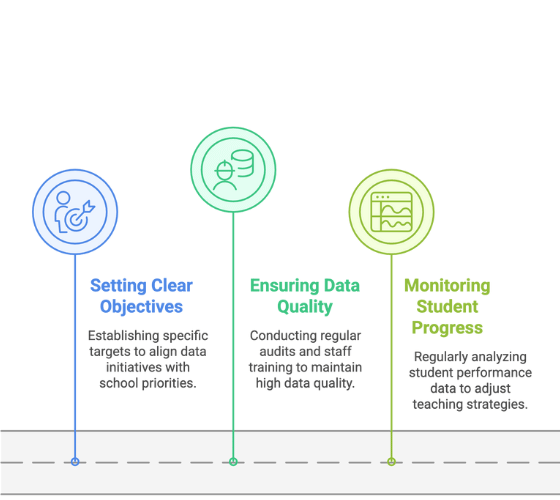Data driven decisions in education use data to enhance learning and optimize teaching methods. By analyzing student performance and behavioral data, educators can identify trends, address learning gaps, and tailor instruction to meet individual needs. This article covers how to build a data-driven culture, key educational data types, best practices, and leveraging technology for improved student outcomes.
Quick Facts To Consider
- 90% of higher education leaders believe that data-driven decision making is crucial for institutional success
- 78% of higher education institutions are using data analytics to make better strategic decisions, according to a 2020 EDUCAUSE survey
- DDDM helps identify at-risk students and provide timely interventions, leading to better academic outcomes
- DDDM provides teachers with tools to create targeted lesson plans, continuously monitor student progress, and adapt teaching strategies in real-time

Data-driven decision making in education transforms abstract challenges into actionable insights, leading to better outcomes. Leveraging data allows educators to address student learning needs and create personalized experiences that significantly improve performance. This approach not only benefits students but also enhances the instructional efficiency of teachers by providing them with concrete evidence to inform their instructional strategies.
Data-driven instruction has proven to be the most effective way to increase student achievement and growth. Continuous analysis of student performance data helps educators identify trends, monitor progress, and adjust teaching methods. This continuous feedback loop ensures that instructional practices are always aligned with student learning needs, leading to improved student success.
Data-driven decision-making helps educators identify students’ strengths and weaknesses, ultimately guiding instruction to improve student comprehension in various subjects.
Relevant data aligned with instructional goals leads to better educational decision-making and improved student performance. Quantitative data, such as test scores and attendance records, provide numerical insights that reveal trends in student performance over time, which is essential for monitoring progress.
Additionally, comprehensive data sets that include teacher observations and student surveys offer a holistic view of the student experience, enabling more informed decisions. Utilizing high-quality data and actionable insights results in better educational outcomes. By embracing data-driven decision making, schools can foster a culture of continuous improvement and ensure that every student receives the support they need to succeed.
Understanding Data Literacy

Data literacy is the cornerstone of effective data-driven decision making in education. It refers to the ability to read, understand, create, and communicate data as information. For educators, this means transforming raw data into actionable insights that can drive instructional improvements and enhance student learning outcomes.
At its core, data literacy involves a deep understanding of various data types, including academic performance data, attendance records, disciplinary data, demographic information, student engagement metrics, and teacher performance data. Each of these data sets provides unique insights into different aspects of the educational experience, and together, they form a comprehensive picture of student and school performance.
To effectively use data, educators must be skilled in data collection, analysis, and interpretation. This involves not only understanding how to gather accurate and relevant data but also knowing how to analyze it to uncover trends and patterns. For instance, assessment data can reveal areas where students are excelling or struggling, while attendance data can highlight issues with student engagement.
Professional development plays a crucial role in building data literacy. Educators can benefit from training sessions that focus on data analysis techniques, interpretation skills, and the practical application of data insights in the classroom. Workshops, seminars, and collaborative learning opportunities can help teachers develop a shared understanding of data literacy and how to use data to inform instruction.
By fostering a culture of data literacy, schools can ensure that educators are equipped to make informed, evidence-based decisions. This not only supports individual student success but also drives overall school improvement. Embracing data literacy empowers educators to create targeted interventions, monitor student progress, and continuously refine their teaching strategies to meet the diverse learning needs of their students.
Building a Data Driven Culture in Schools

Building a data-driven culture in schools is essential for effective decision making. A data-driven environment equips staff and administrators with the insights necessary to make informed decisions that enhance student learning. This transformation begins with effective data management, from collection to operational use, ensuring that data is accurately recorded, analyzed, and utilized to inform instructional strategies.
Collaboration among teachers and administrators is a key component of a successful data-driven culture. When educators work together to analyze data, they can share insights and develop strategies collectively, leading to more cohesive and effective instructional practices. Engaging stakeholders, including parents and the broader community, in evaluating data strategies further enhances accountability and fosters a shared understanding of the school’s goals and progress.
A data-driven culture ensures every decision is evidence-based, resulting in more targeted and effective interventions. This collaborative approach not only supports student success but also drives school improvement by continuously refining instructional methods and identifying areas for growth.
Key Types of Educational Data for Decision Making
Educational data encompasses various types that are crucial for effective decision making. Assessment data, such as grades, standardized test scores, and course completion rates, plays a crucial role in tracking student achievement over time. These metrics provide a clear picture of student performance and highlight areas where students may need additional support.
Attendance records provide valuable insights into student engagement, aiding informed decisions regarding student support. Regular attendance is often correlated with academic success, and identifying patterns in attendance can help educators address potential issues early on. Similarly, behavioral data, which tracks conduct incidents and engagement indicators such as class participation and homework completion, provides a comprehensive view of the student’s overall experience and can inform targeted interventions.
Demographic data, including age, gender, race/ethnicity, and socioeconomic status, is also important for tailoring educational approaches to meet diverse student needs. By analyzing this data, educators can develop strategies that are inclusive and equitable, ensuring that all students have the opportunity to succeed. Together, these data sets create a robust foundation for data-driven decision making in education.

Implementing data-driven instruction requires a strategic approach that aligns with school objectives and fosters a data-driven culture. A deliberate, comprehensive framework is essential for successfully integrating data into instructional practices. This involves regular analysis of benchmark and formative assessments to gain insights into student growth and adjust teaching methods accordingly.
Data literacy training for educators is also crucial. Equipping teachers with the skills to analyze and leverage data effectively ensures that data utilization is tailored to the classroom context and student needs.
By following best practices in data-driven instruction, schools can create a cohesive strategy that enhances student learning and supports continuous improvement.
Setting Clear Objectives
Setting clear objectives is a fundamental step in data-driven decision making. The purpose of setting specific targets is to align data initiatives with school priorities and ensure accountability. Clear goals provide a roadmap for educators, making it easier to evaluate progress and measure the impact of data-driven strategies.
By aligning data initiatives with school priorities, educators can ensure that their efforts are focused on achieving the most significant outcomes. This alignment fosters a sense of unity and purpose, driving collective efforts towards common goals and enhancing overall student success.
Ensuring Data Quality
Maintaining high data quality is essential for effective decision making in education. Regular audits are crucial for ensuring the accuracy and relevance of educational data. Accurate data enables educators to make informed decisions that positively impact student performance.
Staff training on data management practices further enhances the accuracy and usage of educational data. Together, regular audits and staff training contribute to improved student outcomes through better data utilization.
Monitoring Student Progress
Regularly monitoring how students performed is vital for continuous improvement in education. Evaluations of data-driven strategies can be scheduled quarterly or monthly to ensure effective oversight and timely adjustments. Metrics such as improved attendance rates or higher test scores can be leveraged to assess the impact of data-driven strategies.
Regular analysis of student performance data enables educators to monitor progress and adjust their teaching strategies accordingly. Ongoing evaluation keeps instructional methods aligned with student learning needs, supporting student success.
Using Data to Identify and Address Achievement Gaps
Data reveals specific learning gaps, enabling educators to implement targeted interventions for struggling students. Real-time data and predictive analytics can promptly identify at-risk students, enabling timely support. For example, data sets from state assessments can highlight students unlikely to be proficient, allowing educators to provide targeted interventions.
A data-driven approach tailors support to individual needs, enhancing personalized student experiences. Data literacy training helps educators identify trends and make informed decisions that lead to improved student performance.
Addressing achievement gaps can significantly improve state report card scores, reflecting the enhanced performance of underrepresented student groups. By using data to identify and address achievement gaps, schools can ensure that all students have the opportunity to succeed, promoting equity and inclusivity in education.
Classroom Observations Can Help With Data Driven Decision Making
Education Walkthrough offers classroom walkthrough software designed to enable school leaders and instructional coaches to deliver valuable feedback to teachers following classroom observations. This tool plays a crucial role in data-driven decision-making by equipping educators with actionable insights that can enhance classroom dynamics. By systematically collecting and analyzing observational data, teachers can refine their instructional methods, address specific student learning needs, and implement strategies that drive improved student performance.
Overcoming Challenges in Data Based Decision Making
Educators often face challenges in understanding how to effectively interpret and act on data, which may hinder their ability to make informed decisions. Time constraints are a significant barrier for educators when it comes to analyzing data and integrating findings into their teaching practices.
A data-driven culture optimizes resource allocation by directing investments to high-impact areas. By addressing these challenges, schools can ensure that data-based decision making leads to improved student outcomes and overall school improvement.
To overcome these obstacles, schools can implement several strategies. Providing professional development opportunities focused on data literacy can empower educators with the skills needed to analyze and utilize data effectively. This training can include workshops on data interpretation, the use of data analysis tools, and best practices for integrating data insights into lesson planning and instructional strategies.
Additionally, schools can allocate dedicated time for teachers to collaborate and discuss data findings. Establishing regular data review meetings allows educators to share insights, brainstorm solutions, and develop data-informed strategies collectively. This collaborative approach not only enhances the decision-making process but also fosters a supportive environment where teachers feel empowered to experiment and innovate.
Leveraging technology can also streamline data analysis and reduce the time burden on educators. By utilizing advanced data platforms and user-friendly dashboards, teachers can access real-time data insights, enabling them to make timely and informed decisions. These tools can also automate data collection and reporting, freeing up valuable time for educators to focus on instructional planning and student engagement.
By addressing these challenges and implementing effective strategies, schools can create a robust data-driven culture that supports educators in making informed decisions. This proactive approach ensures that data-based decision making translates into tangible improvements in student performance, fostering a culture of continuous improvement and educational excellence.
Wrapping Things Up
Data-driven decision making is a transformative approach that enhances student learning and supports school improvement. By leveraging high-quality data, building a data-driven culture, and utilizing technology for data analysis, schools can make informed decisions that drive student success. Professional development in data literacy empowers educators to effectively use data in their instructional practices, while overcoming challenges ensures that data-based decision making leads to continuous improvement.
Embracing data-driven decision making is essential for creating personalized learning experiences and closing achievement gaps. By fostering a culture of data-driven instruction, schools can ensure that every student receives the support they need to succeed, ultimately transforming the educational landscape.
What is the data-driven decision-making model in education?
The data-driven decision-making model in education involves systematically collecting, analyzing, and interpreting various data sources to inform instructional strategies and improve student outcomes. This model helps educators make evidence-based decisions that enhance teaching effectiveness and student learning.
What are the 4 steps of data-driven decision-making?
The four steps of data-driven decision-making include data collection, data analysis, data interpretation, and action planning. By following these steps, educators can effectively use data to identify trends, address learning gaps, and implement targeted interventions.
What are data driven practices in education?
Data-driven practices in education refer to the systematic use of student data to inform teaching methods, curriculum design, and educational policies. These practices include analyzing assessment data, monitoring attendance patterns, and evaluating student engagement to tailor instructional strategies to meet diverse learning needs.
Why is it important to use data to drive decisions in the classroom?
Using data to drive decisions in the classroom is important because it allows educators to make informed instructional choices that enhance student learning and performance. By leveraging data, teachers can identify student strengths and weaknesses, implement targeted support, and continuously refine their teaching practices to promote student success.



